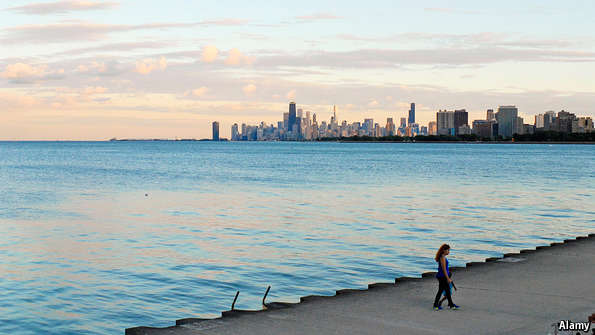Could water be the Midwest’s ticket to economic rebirth?
CYCLING to and from work along the shores of Lake Michigan in the summer months, marvelling at the brilliant turquoise water in the morning and shades of pink, purple and deep blue in the evening, ever-varying with wind and weather, is a treat for Chicagoans. The lake makes a majestic backdrop for the city’s splendid architecture, and its beaches are a meeting place for people of all classes and colors in this still segregated place.
Lake Michigan and the four other lakes in the region are also the most important asset for Chicago’s home state, Illinois, and the seven other American states that border the Great Lakes, according to a vocal school of thought in the Midwest. “We wrecked our water by leading the industrial revolution,” says John Austin, director of the Michigan Economic Centre. “Now we have to reclaim it to secure our future.”
The Midwest’s industrial boom was carried along by water. It was an important input for the car industry in Detroit, for breweries in Milwaukee, steelmakers in Gary, paper manufacturers in Muskegon and makers of furniture in Grand Rapids. Industries and communities flocked to river- and lakefronts (Chicago had both). Water lubricated the new activity—and helped transport raw materials and finished wares. The new industrialists could use water at scale—and they abused it, pouring toxic waste into the sea-like lakes.
For a long time Midwesterners ignored the damage done. It took fires on the Buffalo, Rouge, Detroit and Chicago rivers, fuelled by thick, oily sludge in the lakes and their arteries, for that to change. In 2010 the Great Lakes Restoration Initiative was born to improve water quality, clean up shorelines and restore habitats and species. Five years later, on July 28th, the Environmental Protection Agency (EPA) submitted a progress report on the initiative to Congress. It says that five areas of concern have been cleaned up, 148,000 acres of wetlands, islands and coastal habitat restored, phosphorus run-off from farms reduced and invasive species rebuffed.
More needs to be done to clean up the lakes and rivers, but attention is now shifting from conservation to the economic uses of abundant water. The Midwest has more than 20% of the world’s (and 80% of America’s) freshwater supply. It is trying to position itself as a centre for research and development for water-related technologies. Milwaukee’s Water Council, which promotes investment, research and jobs in water technology, wants the region to be a wetter version of Silicon Valley. Its Global Water Centre is an incubator for water-based companies. The School of Freshwater Sciences at the University of Wisconsin’s Milwaukee branch is one of only three such freshwater schools in the world (the other two are in the Netherlands and in Singapore). Milwaukee calls itself the “World Water Hub”. Delegations of visitors from around the world seem to believe it.
Curiously, given the abundance of the stuff, several corporate pioneers in water conservation and technology have their headquarters in the Midwest. Ford, a carmaker, has reduced the amount of water used per vehicle produced by 30% in recent years, by assigning pipes for workers’ drinking water in each plant and recycling all the rest, as well as by using less water to paint its cars. Cascade Engineering, a maker of car parts in Grand Rapids, produces cheap water filters for the developing world. Kohler, a Wisconsin-based maker of loos and washbasins, and Whirlpool, a maker of washing machines and dishwashers from Michigan, have joined forces to try and eliminate waste water. Over the next couple of years the companies hope to find ways to make more homes entirely self-sustaining through the collection, storage and purification of rain and snow.
In addition to becoming a home for technological innovations, the Midwest hopes to attract water-guzzling industries such as food processing and chemicals to the Great Lakes’ shores. For even if parched states such as California have their thirsty eye on the Midwest’s water, the region’s precious liquid cannot travel far. In 2008 the Great Lakes Compact between the eight states bordering the lakes and Canada’s Ontario and Quebec banned the diversion of water beyond the Great Lakes watershed, with few exceptions. Dean Amhaus, head of the Water Council, thinks climate change will in time turn water scarcity into a more pressing concern. That could in turn transform the Midwest from economic drifting to something like its former prosperity.
